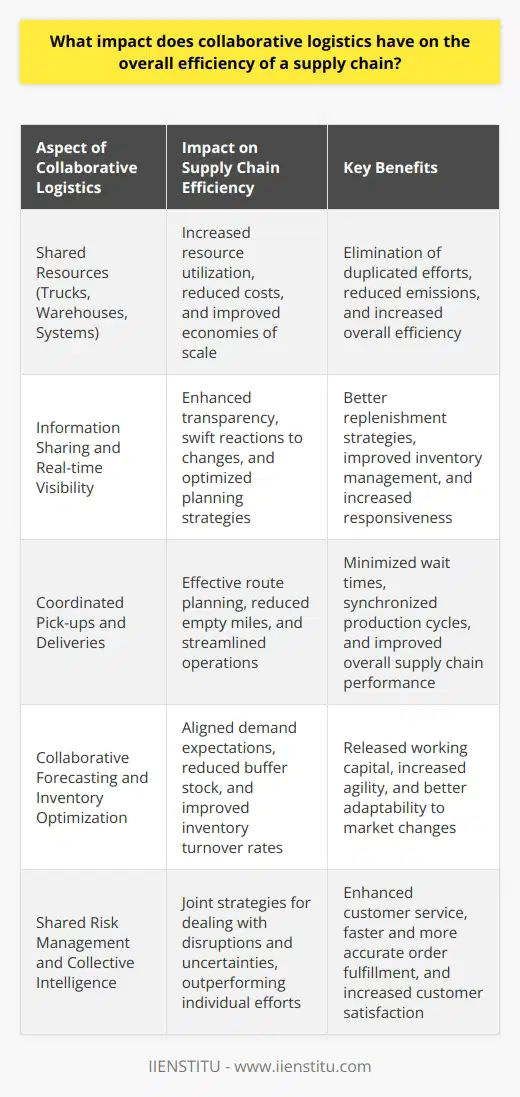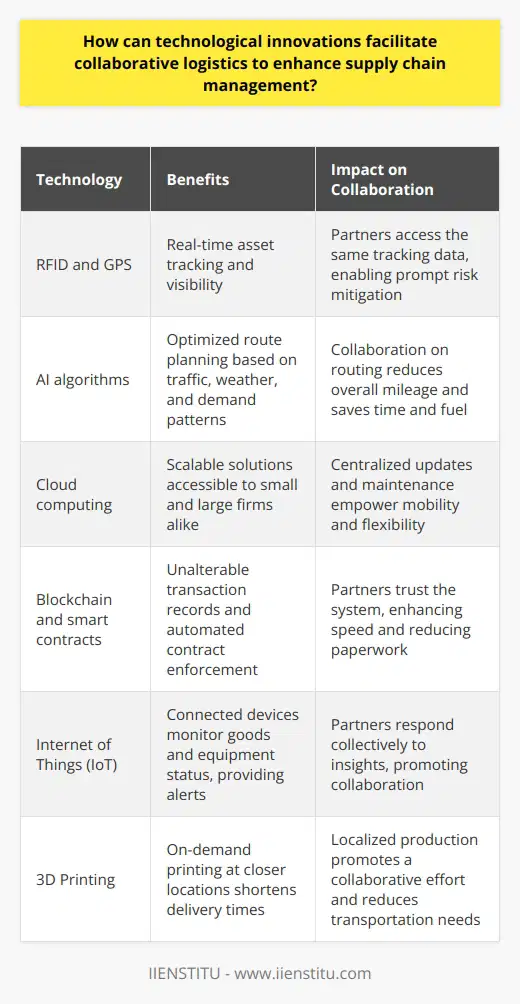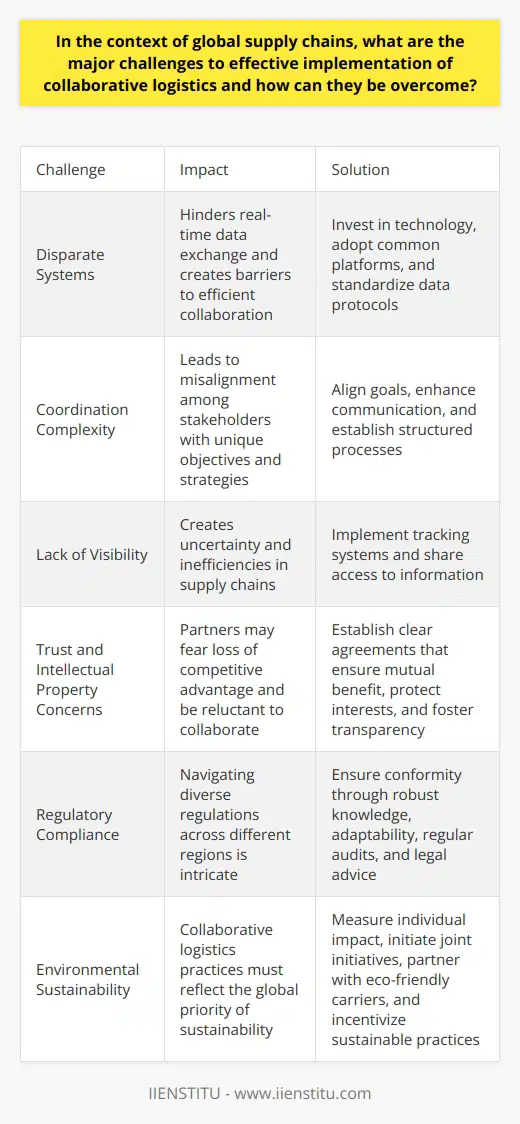
Today's supply change landscape is both complex and dynamic, requiring an agility and foresight that traditional models lack. One strategy that has garnered significant attention in this rapidly evolving field is collaborative logistics. Unlike traditional logistics that often work in silos, collaborative logistics leverages shared expertise, resources, and information, leading to a more synchronized and efficient supply chain. This progressive approach has reshaped how businesses think about and manage their supply chain operations, making it an essential study in the context of modern commercial success.
This article dissects the depths of collaborative logistics, explores its conception, benefits, and practical applications, and aims to provide a comprehensive understanding of this innovative methodology.
The Concept of Collaborative Logistics
Explaining Collaborative Logistics
At its core, collaborative logistics is about creating partnerships among various stakeholders in the supply chain to leverage collective benefits. This involves a shift from an insular focus where each entity operates independently, to a concerted approach where activities and information flow seamlessly among parties. It is the cooperative spirit aggrandized by strategic alliances that distinguishes collaborative logistics from more individualistic methods.
Logistics, in this context, is not merely the movement of goods but the synchronized coordination of supply chain processes.
The Evolution of Collaborative Logistics
The transformative leap from traditional to collaborative logistics reflects a response to limitations in the former, which often led to inefficiencies such as duplicative efforts and competition for the same resources. As technology evolved, particularly with the advent of the internet and logistics software, the feasibility and desirability of collaboration became clear.
Business partners began sharing data through integrated systems, facilitating real-time decision-making and responsiveness. This evolution has been propelled by a market that prizes agility and sustainability, pressuring logistics providers to adapt.
Digital Transformation İmpact On Supply Chain İnterview Question
Critical Role Of Cold Chain Logistics İn İndustry Efficiency And Reliability
Core Elements of Collaborative Logistics
Certain pillars underpin the successful application of collaborative logistics. At the forefront, shared resources create a consolidated approach to the use of transportation and warehousing, generating cost efficiencies. Transparency and trust between entities ensure there is open communication and that partners are working with rather than against each other. Additionally, sharing information allows for better forecasting and streamlined operations.
Performance metrics further enable partners to measure the success of their collaborative efforts and reassess strategies for improved outcomes.
Benefits of Collaborative Logistics
Cost Saving
Financial incentives play a pivotal role in the push towards collaborative logistics, with cost savings realized in several areas. Transportation costs may drop as a result of coordinated delivery schedules and shared shipping space, circumventing redundant vehicle use. Inventory carrying costs can likewise diminish when information sharing leads to more refined demand forecasts, thus reducing excess stock.
Ultimately, the interplay of these factors compounds to provide an economy of scale seldom achievable in isolationist logistics environments.
Improved Service Levels
Collaboration not only augments fiscal health but elevates service delivery too. The dynamism afforded by collaborative systems empowers businesses to adapt quickly to market changes, avoiding stockouts or overages. This boosts the customer experience, providing more consistent availability and reliable produce.
The resultant refinement of service quality can differentiate companies in today's competitive marketplace, where consumer expectations are ever-increasing and brand loyalty is becoming increasingly elusive.
Enhanced Supply Chain Efficiency
Optimum supply chain efficiency is pivotal to a lean operation. Collaborative logistics often leads to reduced lead times, as shared planning and operations prevent bottlenecks. Accurate forecasting, enabled by shared data, minimizes waste and maximizes resource utilization.
Effective inventory management systems emerge from these combined efforts, contributing to a more predictable and reliable supply chain.
Implementing Collaborative Logistics
Requisites for Successful Implementation
A successful collaborative logistical framework rests upon several key requisites. Choosing the right partners whose capabilities and corporate philosophies align with one's own is central to constructing a functional alliance. Robust communication methodologies and systems are required to facilitate uninterrupted and clear dialogue between participants, while data must be readily available and transparent for informed collective decision-making.
Overcoming the Challenges
Adopting a collaborative approach is not without its hurdles. Resistance to change can stifle innovation and progress. Companies must also grapple with issues of confidentiality, carefully navigating the sharing of sensitive information. Enforcing compliance across various entities calls for a delicate balance of shared governance and autonomy.
Steps to Implement Collaborative Logistics
To implement collaborative logistics, companies should first identify potential partners demonstrating compatibility and mutual benefit. Solidifying trust and establishing robust, secure communication channels are paramount. Aligning objectives and harmonizing operational processes ensures that activities are not only coordinated but also aim toward unified goals.
Case Studies and Examples of Collaborative Logistics
Successful Collaborative Logistics Initiatives
Coca-Cola and Heinz set a sterling example of collaborative logistics with their mutual transportation collaboration, maximizing truckload efficiency and reducing environmental impact. Similarly, Walmart and P&G's collaborative forecasting initiative leveraged both companies' strengths, enhancing inventory management and consumer demand fulfillment.
Lessons Learnt from Successful Implementation
These successful ventures underscore the imperativeness of trust, transparency, and sharing goals for mutual gain. When businesses enter collaborations with these values in mind, the results can lead to significant benefits across the board, redefining industry practices and elevating standards.
Understanding the Pitfalls through Failed Attempts
The partnership between Daimler and BMW failed due to a divergence in corporate cultures and visions, illuminating the vital need for aligned corporate values and goals. The Borders and Amazon alliance unraveled, teaching the harsh lesson that, without strategic alignment and a joint vision for the future, even the most promising collaborations can falter.
Future of Collaborative Logistics
As the logistics landscape continues to evolve, collaborative logistics stands as a beacon of innovation, heralding a future where integration, efficiency, and sustainability coexist. Its growing significance alludes to an impending universal adoption across the logistics industry.
Essential Takeaways for Businesses
Businesses should heed the advantages of collaborative approaches and consider their applicability within their own supply chains. The shift from traditional logistics to a collaborative model can be transformative and demands a thoughtful, strategic approach.
Closing Remarks
In conclusion, collaborative logistics is an evolutionary advancement in supply chain management that accommodates modern business challenges. It is a concept that breaks down operational barriers, engenders trust, and fosters transparent communication, offering savings, efficiency, and service improvements that prop up competitive advantage. As companies shift their gaze to the horizon of collaborative enterprise, the leaders of these initiatives are shaping the very contours of future commerce.
For those interested in delving deeper into this subject, shipping and logistics courses continue to emerge, often accessible through online courses, offering individuals and businesses alike the opportunity to equip themselves with expertise for the collaborative age.
Frequently Asked Questions
What impact does collaborative logistics have on the overall efficiency of a supply chain?
Understanding Collaborative Logistics
Collaborative logistics represents a shift. It moves away from isolated operations. Firms work together to coordinate their logistical operations. They share transportation, storage, and management information sytems. This collaboration yields numerous benefits. It tackles the complexities of supply chain management.
Supply chains are intricate systems. They consist of many independent firms. Each firm has its own goals and processes. Collaboration eases the tension between these goals. It enables greater harmony. Collaborative logistics makes this harmony possible. It does so through shared vision and incentives.
Increased Efficiency Through Shared Resources
Resource Utilization
Collaboration increases resource utilization. Companies share trucks, warehouses, and systems. This leads to economies of scale. Costs reduce due to this pooling of resources.
Reduced Redundancies
Duplication of efforts reduces. Two companies no longer send half-full trucks to the same destination. They combine their loads. They make one trip. This step cuts emissions and costs. It boosts efficiency.
Enhanced Information Sharing
Information sharing is critical. It provides real-time visibility. Partners can access data about product flow and demand. This transparency lets firms react swiftly. It allows for better planning and replenishment strategies.
Streamlining Operations Across Supply Chain
Coordinated Transportation
Firms can coordinate pick-ups and deliveries. They do this through a single transportation system. The system plans routes effectively. It reduces empty miles.
Optimized Inventory Management
Collaborative forecasting aids inventory optimization. Partners align on expected demand. They reduce buffer stock. Inventory turnover rates improve. It releases working capital.
Synchronized Production Scheduling
Production schedules can align. Firms work together to synchronize their manufacturing. This minimizes wait times for materials. It smooths out production cycles.
Impact on Flexibility and Responsiveness
Agility
The supply chain becomes more agile. Partners can adapt quickly to market changes. They can scale operations up or down. They do this as demand dictates.
Risk Management
Shared risks lead to better risk management. Partners develop joint strategies. They deal with disruptions and uncertainties. Their collective intelligence outperforms individual efforts.
Customer Service
Improved efficiency enhances customer service. Orders arrive faster. They are more accurate. Customer satisfaction rates climb.
Collaboration in logistics reshapes supply chains. It improves performance metrics. Partners benefit from reduced costs and increased agility. They thrive with higher service levels. Collaborative logistics is not just an option. It is a strategic imperative. It ensures competitiveness in a complex, demanding marketplace.

How can technological innovations facilitate collaborative logistics to enhance supply chain management?
Collaborative Logistics through Technology
Bridging Communication Gaps
Innovative tech removes communication barriers. Enhanced data exchange fosters trust. Secure platforms enable real-time information sharing. This transparency streamlines coordination.
Advancing Tracking and Monitoring
RFID and GPS technologies revolutionize asset tracking. Real-time visibility allows for proactive response. Partners access the same tracking data. This access mitigates risks promptly.
Optimizing Route Planning
AI algorithms elevate route optimization. They analyze traffic, weather, and demand patterns. Smart routing saves time and fuel. Collaboration on routing reduces overall mileage.
Integrating Platforms
Common technology platforms link partners. They merge data across the supply chain. Inventory and demand forecasts become shared knowledge. Integration prevents stockouts and excess inventory.
Utilizing Cloud Computing
Cloud computing offers scalable solutions. Small and large firms access the same tools. Updates and maintenance are central and efficient. The cloud empowers mobility and flexibility.
Smart Contracts and Blockchain
Blockchain creates unalterable transaction records. Partners trust the automated contract enforcement. Smart contracts execute upon agreed conditions. They enhance speed and reduce paperwork.
Internet of Things (IoT)
IoT connects devices across the chain. Sensors monitor goods and equipment status. Alerts provide immediate knowledge of issues. Partners respond collectively to these insights.
3D Printing
On-demand printing at closer locations shortens delivery times. It cuts down on transportation needs. Localized production promotes a collaborative effort.
Big Data Analytics
Data analytics offer predictive insights. Partners anticipate demand and adjust accordingly. They collaborate to meet customer requirements better. Analysis also identifies inefficiencies for improvement.
Robot Process Automation (RPA)
RPA facilitates mundane and repetitive tasks. Machines handle ordering, invoicing, and customer service. Employees focus on strategic planning. Collaboration enhances as partners focus on core activities.
Technological advancements are redefining collaboration in logistics. They offer ways to synchronize activities among partners. Enhanced visibility, communication, and automation support these efforts. Supply chain management turns more robust and agile.

In the context of global supply chains, what are the major challenges to effective implementation of collaborative logistics and how can they be overcome?
Collaborative Logistics: Challenges and Solutions
The Challenge of Disparate Systems
Global supply chains rely on logistics collaboration. They face the issue of disparate systems. Each company operates with its own systems. These systems often lack interoperability. Disparate systems hinder real-time data exchange. They create barriers to efficient collaboration. The solution lies in investing in technology. Common platforms must be adopted. Standardization of data protocols is crucial. This will enable seamless information flow.
The Complex Dance of Coordination
Another major challenge is coordination. Multiple stakeholders are involved in supply chains. Each has unique objectives and strategies. These differences can lead to misalignment. Coordination is complex and resource-intensive. To overcome this, stakeholders must align goals. Communication is key. Structured processes must be put in place. They will ensure consistent and effective collaboration.
Visibility Across the Chain
Visibility is integral to collaborative logistics. Lack of visibility creates uncertainty. It leads to inefficiencies in supply chains. The remedy involves implementing tracking systems. It also calls for shared access to this information. Partners can then anticipate disruptions. They can adapt to changes swiftly.
Trust and Intellectual Property Concerns
Trust issues also pose a challenge. Partners may fear the loss of competitive advantage. Intellectual property concerns can cause reluctance. Overcoming this requires clear agreements. Agreements that ensure mutual benefit and protect interests. Transparency must be established. It lays the foundation for trust. Trust takes time but offers significant rewards.
Regulatory Compliance
Different regions have diverse regulations. Navigating these is often intricate. Compliance requires robust knowledge and adaptability. Backed by expertise, firms can ensure conformity. Regular audits and legal advice are vital. They support a proactive approach to compliance.
The Environmental Factor
Sustainability is now a global priority. Collaborative logistics practices must reflect this. However, there's no one-size-fits-all solution. Each company needs to measure its own impact. Joint initiatives can amplify sustainability efforts. Collaboration can help spread green practices. Partnering with eco-friendly carriers may be essential. Incentives for sustainable practices can also drive change.
The Human Element
Finally, the human element is pivotal. Change resistance is a natural phenomenon. Staff training is important. It ensures that personnel adapt to new systems. Clear communication keeps teams informed. Participation and feedback foster a culture of collaboration.
Collaboration-driven logistics is the future of supply chains. It demands commitment, investment, and a shared vision. It also involves embracing technology and sustainability. Through persistent effort, firms can navigate these challenges. They can unlock the full potential of collaborative logistics.



